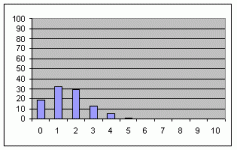aarthrj3811 said:
We know the odds are 1 in 100 to get the date right in my first example. It's not a guess, and it is based on "real facts."
And where can one find these "real facts"?
Oy vey, Art. It's math, buddy, not dowsing..... Okay, one more time. This is using my example, not the actual test.
You have 10 coins in front of you, each with a different date, from 1990 to 2000. You have to pick one from this 10. This choice gives the odds of 1 in 10. One coin from the row of 10. 1 in 10. Agreed?
Okay, with your one coin, you have to assign a date to it. You have 10 possible dates, from 1990 to 2000. This is, again, 1 in 10. Understand?
Now, you have a 1 in 10 choice of coins and a 1 in 10 choice of dates, but this has to be done with only one coin. It's probability at play here, with 10 choices and 10 more choices, you have 100 possible combinations without knowing any other information about the coins. But you only get one guess. So your guess is 1 out of 100 possibilities. 1-to-100 odds. Real facts. Real math.
Oh, and to answer your question even more directly, try a 9th grade math textbook.



 True though.
True though. 

